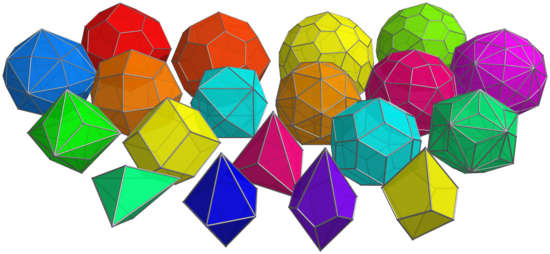The Catalan Solids
The Catalan Solids are the duals of the uniform polyhedra. They are face-transitive, but generally not vertex- or edge-transitive, and have multiple edge lengths and non-regular faces.
Two of the Catalan solids, the pentagonal icositetrahedron and the pentagonal hexecontahedron, are chiral, because their dual uniform polyhedra, the snub cube and the snub dodecahedron, are chiral. Thus they are shown in two mirror images in the above image.
Due to the fact that the Catalan solids are duals of the uniform polyhedra, they have some interesting properties:
- They are face-transitive;
- All their vertex figures are regular polygons;
- All dihedral angles are equal;
- The angles between adjacent edges around a vertex are all equal.
Classification
Being duals of the Archimedean solids, the Catalan solids follow the same classification according to the symmetry families of the Platonic solids.
The Tetrahedron Family
The tetrahedron family comprises of 5 members, but only one is distinct, because there is only one distinct uniform polyhedron in the tetrahedron family after discounting regular members, members that are identical due to the self-duality of the tetrahedron, and members identical to a member in the cube family due to the tetrahedron being the alternation of the cube.
(Dual of the rectified tetrahedron: regular.)
(Dual of the dual tetrahedron: identical to the triakis tetrahedron.)
(Dual of the cantellated tetrahedron: identical to the rhombic dodecahedron.)
Triakis tetrahedron (dual of the truncated tetrahedron): bounded by 12 isosceles triangles with edge ratios 3 : 3 : 5.
(Dual of the omnitruncated tetrahedron: identical to the tetrakis hexahedron.)
The Cube Family
The cube family consists of 6 members. The pentagonal icositetrahedron, like its dual snub cube, is chiral, and comes in two enantiomorphs (mirror images).
Rhombic dodecahedron (dual of the cuboctahedron): bounded by 12 rhombuses with diagonal ratios 1 : √2.
Tetrakis hexahedron (dual of the truncated octahedron): bounded by 24 isosceles triangles with a 3 : 3 : 4 edge ratio.
Deltoidal icositetrahedron (dual of the rhombicuboctahedron): bounded by 24 kites with a (4+√2) : (4+√2) : 7 : 7 edge ratio.
Triakis octahedron (dual of the truncated cube): bounded by 24 isosceles triangles with a (6−4√2) : 1 edge ratio.
Disdyakis dodecahedron (dual of the great rhombicuboctahedron): bounded by 48 scalene triangles with edge ratio √(22−12√2) : 3 : 2√(9−4√2).
Pentagonal icositetrahedron (dual of the snub cube): bounded by 24 scalene pentagons.
The Dodecahedron Family
The dodecahedron family also consists of 6 members. The pentagonal hexecontahedron, like its dual snub dodecahedron, is chiral, and comes in two enantiomers (mirror images).
Rhombic triacontahedron (dual of the icosidodecahedron): bounded by 30 rhombuses with a 1 : φ diagonal ratio.
Pentakis dodecahedron (dual of the truncated icosahedron): bounded by 30 isosceles triangles with edge ratios 12+3φ : 12+3φ : 19.
Deltoidal hexecontahedron (dual of the rhombicosidodecahedron): bounded by 60 kites with edge ratio 3√(17−7φ) : 11 and diagonal ratio 3(5φ−7) : 2√(11−5φ).
Triakis icosahedron (dual of the truncated dodecahedron): bounded by 60 isosceles triangles with edge ratio (8−φ) : 11.
Disdyakis triacontahedron (dual of the great rhombicosidodecahedron): bounded by 120 triangles with edge ratio 5√(5−3φ) : 3 : 2√(29−16φ).
Pentagonal hexecontahedron (dual of the snub dodecahedron).
The Duals of Prisms & Antiprisms
Although the Catalan solids themselves, as studied by Eugène Catalan, include only the duals of the Archimedean solids, we can extend this category of 3D polyhedra to include the duals of the prisms and antiprisms as well. Under this expanded definition we obtain the infinite families of the bipyramids and the n-gonal trapezohedra. Since there are an infinite number of them, we only list a few representative examples here.
Triangular bipyramid (dual of the triangular prism): bounded by 6 isosceles triangles with edge ratio 2 : 2 : 3.
Triangular trapezohedron (identical to the cube).
Square bipyramid (identical to the octahedron).
Square trapezohedron (dual of the square antiprism): bounded by 8 kites with edge ratio (2−√2) : 1 and diagonal ratio √2 : √(1+2√2).
Pentagonal bipyramid (dual of the pentagonal prism): bounded by 10 isosceles triangles with edge ratio 3−φ : 2.
Pentagonal trapezohedron (dual of the pentagonal antiprism).
Some of these polyhedra are topologically equivalent to a few identically-named Johnson solids. However, they have different proportions and diverse edge lengths, and should not be confused with each other. For example, the Johnson solid J12 is also called a triangular bipyramid; however, its dual is a non-uniform triangular prism. The dual of the uniform triangular prism is the differently-proportioned triangular bipyramid above, which, unlike J12, has unequal edge lengths.
This may seem like an insignificant difference, but it does have important consequences: for example, the dual of the rectified 5-cell is bounded by triangular bipyramid cells—the non-Johnson kind, dual to the uniform triangular prism. The Johnson triangular bipyramid, J12, does not have the right proportions and does not fold up correctly in 4D to form the dual of the rectified 5-cell, in spite of being topologically equivalent to the dual of the uniform triangular prism.





